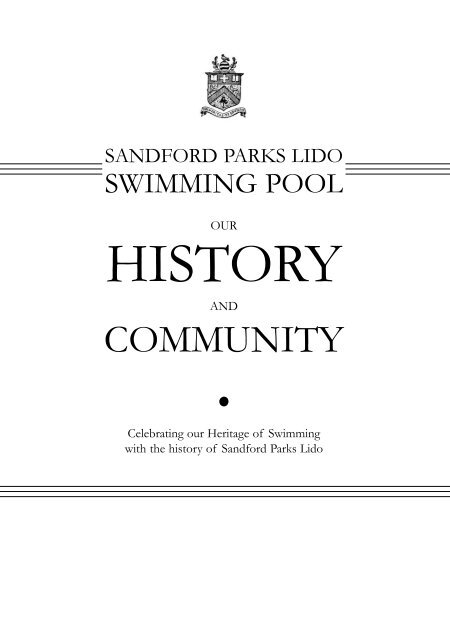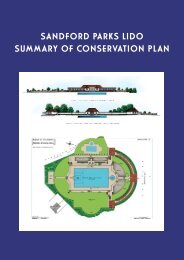heritage leaflet.pdf - Sandford Parks Lido
heritage leaflet.pdf - Sandford Parks Lido
heritage leaflet.pdf - Sandford Parks Lido
Create successful ePaper yourself
Turn your PDF publications into a flip-book with our unique Google optimized e-Paper software.
<strong>heritage</strong> <strong>leaflet</strong>.qxp 19/06/2007 09:19 Page 1SANDFORD PARKS LIDOSWIMMING POOLOURHISTORYANDCOMMUNITY.Celebrating our Heritage of Swimmingwith the history of <strong>Sandford</strong> <strong>Parks</strong> <strong>Lido</strong>
<strong>heritage</strong> <strong>leaflet</strong>.qxp 19/06/2007 09:20 Page 2ContentsPage2 Foreword3 History of Swimming4 Swimming in Cheltenham5 History of <strong>Lido</strong>s7 Concept of <strong>Sandford</strong> <strong>Parks</strong> <strong>Lido</strong>Clive Barratt on the Cafe steps inthe 1950s9 History of <strong>Sandford</strong> <strong>Parks</strong> <strong>Lido</strong>13 Charitable trust13 History of problems15 Funding secured16 Refurbishment 2006/717 The living archive18 Tour & mobile talks18 Other sources19 Our conservation policy22 AcknowledgementsFront cover of the 1935 openingceremony programme1
<strong>heritage</strong> <strong>leaflet</strong>.qxp 19/06/2007 09:20 Page 3ForewordFollowing the successful refurbishment of our main pool and surrounding area in 2006/07we felt it an appropriate time to document the history of swimming. To celebrate the 1930sboom in lidos and their struggle for survival in a changing world and highlight the successstory of <strong>Sandford</strong> <strong>Parks</strong> <strong>Lido</strong>.The passion of local people prevented its closure and the dedication and hard work of theCharitable Trust has now secured the future of our beloved lido. Many individuals have beeninstrumental to the preservation of our lido and we would like to thank you all for your dedicationover the years.We hope you enjoy reading about our history and continue to experience the delights of lidolife.We invite you to send us your personal memories and documents that best portray yourexperience of our unique facility for inclusion on our 'Living Archive'.J SargentJulie SargentChief Executive2
<strong>heritage</strong> <strong>leaflet</strong>.qxp 19/06/2007 09:20 Page 4History of SwimmingThe activity of swimming is not a modernconcept. Humans have been entering thewater since the Stone Age. The earliestrecord can be found in the drawings at "thecave of swimmers" near Waid Sora (orSura) in Egypt. Another Egyptian wallrelief shows soldiers of Pharaoh RamessesII (1279 BC - 1213 BC) pursuing their enemiesby swimming across the OrontesRiver. There is also archeological evidencedating back to 2500 BC suggesting thatSouth Pacific Islanders taught their children toswim as soon as they were able to walk. Written‘Cave of Swimmers’ drawing found inEgyptreferences to swimming can be found in the Iliad, the Odyssey and the Bible (Ezekiel 47:5,Acts 27:42, Isaiah 25:11).In ancient Greece and Rome swimming was an important activity, especially as a form oftraining for warriors. One common insult in Greece was to say 'you neither know how torun or to swim'. Plato thought men who did not know how to swim were uneducated. Theability of the Greeks to swim is said to have saved them at the Battle of Salamis, where thePersians drowned when their ships were destroyed. In ancient Rome swimming was regardedas a healthy practice and races were held in the Tiber River. Swimming was initially oneof the seven agilities of knights during the Middle Ages including the ability to swim witharmour. It was subsequently discouraged as swimming was usually carried out in a state ofundress and was opposed by the church. Immersion in water was associated with the recurrentepidemics of the time. In 1587 a Cambridge Scholar, Everard Digby wrote 'De ArteNatandi' in which he claimed that humans can swim better than fish.In 17th-century Britain the medicinal benefitsof natural spa springs were beingutilised, with the idea that hygiene promotedhealth. During the reign of George III(1738 - 1820), sea bathing was popularisedby the king himself and bathing resortssuch as Weymouth became fashionable. Bythe 19th century, Subscription Baths run byprivate companies offered small plungebaths but it was not until 1829 that the firstpublic municipal swimming bath appeared inLiverpool, the St George's Pier Head Baths builtat a cost of £24,481.King George III bathing in the sea atWeymouth 17893
<strong>heritage</strong> <strong>leaflet</strong>.qxp 19/06/2007 09:20 Page 5The 1846 Baths and Washhouses Act allowed local authoritiesto borrow money for the purpose of building baths andwashhouses for the health and hygiene of working people.Amendments to the Act in 1870 and 1898 gave more prominenceto swimming pools and the public’s increased leisuretime led to a boom in the popularity of swimming. Theswimming pools of this period were strictly segregatedaccording to sex and class and were used as concert halls,meeting places, gymnasia and boxing venues during the wintermonths.By 1896, swimming had become an established sport and wasincluded in the first modern Olympic Games of that year. InJohnny Weismuller1922 Johnny Weismuller became the first person to swim 100min less than a minute and his career of five Olympic medals, 36 national championships andnever losing a race in his ten-year career boosted the popularity of swimming. His secondcareer as a film star, appearing as Tarzan in twelve films, also promoted the ability to swim.In 1972 Mark Spitz, at the height of his career, made history by winning an unbeaten recordof seven Olympic medals in Munich.Early baths were filled at the beginning of the week with fresh water and by the end of theweek the water was murky. As a consequence the cost to swim was reduced throughout theweek. The wealthy would swim at the beginning and the poor at the end of the week. The1930s brought a greater emphasis on water clarity of pools and filtration and chlorinationwas introduced. At the same time a boom in open air swimming and sun worship arose andhundreds of lidos were built across the country.Swimming In CheltenhamCheltenham began to develop as a spa townin the 18th century, and after the 1820s it rapidlydeveloped from the core of the medievaltown. By the 1930s it had a population of62,432 (1931). Like other spa townsCheltenham already had a wide range ofbathing facilities. These included HenryThompson's Montpellier Baths (now theCheltenham Playhouse Theatre) whichopened in 1806. In March 1898 the medicinalbaths were purchased by the CheltenhamCorporation and later converted to a swimming pool andMontpellier Bathsslipper baths. The tiled swimming pool still exists beneath the floor of the main auditoriumand serves as a store for stage rostra and other theatrical properties.4
<strong>heritage</strong> <strong>leaflet</strong>.qxp 19/06/2007 09:20 Page 6The first swimming facility in Cheltenham wasthe Alstone Baths which were opened on June21st 1887. This facility was well used by the localpopulation and especially the CheltenhamSwimming and Waterpolo Club. Unfortunately itwas closed in 1978. Also dating from the 1880sis the Boys College swimming pool on CollegeBaths Road just to the east of the lido, which isnow used as offices for Cheltenham GeneralHospital.The Alstone BathsOn May 4th 1971 the Queen Mother officially opened the Pittville Recreation Centre. It wasrefurbished and reopened in 2003 with the new identity of ‘leisure@cheltenham’.History of <strong>Lido</strong>sThe construction of hundreds of lidos in Britain during the 1930s was fuelled in part by thepopularity of swimming, and the drive by national and especially local government toimprove health and general fitness for the population. In 1926 Miss Gertrude Ederle wasthe first woman to swim the English Channel, beating the then male record by two hours,and the evolution of bathing apparel for women made swimming more accessible andacceptable. Before this women would effectively have to wear a costume which covered theirbody, legs and arms which was not really effective for swimming. The 1929 'Jantzen'designed costume was launched with the slogan'the suit that changed bathing intoswimming'. At the same time, sun worshipor sun bathing and enjoying the pleasuresand virtues of fresh air in the outdoors wasthe activity of choice and beach resortsboomed. Travelling to the seaside was notan option for everyone and local authorities,motivated to improve the health oftheir community, planned and created theoutdoor swimming arenas that were to bepopularly known as lidos.The term ‘lido’, derived from the Latin‘litus’ meaning 'shore' and was borrowedfrom the 11 mile long island that separatesVenice, Italy from the Adriatic Sea. Thename of this famous seaside resort with itssandy beach suitable for swimming hasbeen used worldwide.5
<strong>heritage</strong> <strong>leaflet</strong>.qxp 19/06/2007 09:20 Page 8Concept of <strong>Sandford</strong> <strong>Parks</strong> <strong>Lido</strong>Revised drawing including the Cafe complex 1934The style of the buildings at Cheltenham owes much to earlier public park and garden architecture.This traditional style contrasts with some of more modernistic seaside lidos builtelsewhere in Britain in this period. Buildings, walls, the pool and the planned landscape contributeto the site's individual character and provide a strong sense of enclosure to the visitor.Lawns to the south and west and sun decks to the north and east of the pool weredesigned to meet the needs of sun worship and activities alike. The lido is set within a landscapeplanted with a rich variety of shrubs and trees, including Lombardy poplar and yewhedges - these have now matured and are an essential part of its character.It is significant that Cheltenham councillors had visited the lido at Guildford, which was alsobuilt within a lush parkland landscape with similar style buildings, prior to the designs beingprepared for <strong>Sandford</strong> <strong>Parks</strong> <strong>Lido</strong>. Gould Marsland, the Borough Engineer, worked thebuildings, pool and landscaping into an ambitious overall concept, which displayed a verystrong awareness of how the planning of lidos as outdoor architecture presented opportunitiesto harness the regenerative qualities of air and sunlight. This is what makes <strong>Sandford</strong><strong>Parks</strong> <strong>Lido</strong> so special and significant, as it was developed and still survives as a site where thepool, buildings and landscape were all designed as a unified whole.7
<strong>heritage</strong> <strong>leaflet</strong>.qxp 19/06/2007 09:20 Page 9Other lidos, such as the pools built by London County Council between 1937 and 1939, werebuilt as tightly-enclosed groups in the latest architectural style. Others, such as theInternational Modern style Saltdean <strong>Lido</strong> in Brighton, are noted for their individuallyremarkable buildings, whilst some are located in park landscapes.The drawings of August 1934 show how the Borough Engineer, Gould Marslandapproached the design of the lido, and its links via a now-closed entrance to the newlyopenedplaying ground at <strong>Sandford</strong> Park. The buildings embrace in curved quadrants boththe north and south ends of the site. They comprise a main south entrance with ticket office,turnstiles and flanking changing cubicles and toilets, and a café and flanking open-sided loggiasopposite.The focal point of the overall design is the pool, its length (165 feet, just over 50 metres)conforming to the standards then promoted by the Amateur Swimming Association.Considerable thought was given to the patterns of circulation and movement around thepool. The bather would move from the main entrance and ticket office to change in theoutside cubicles and take their basket of clothing to the basket store (now the heated changingrooms) to hand to an attendant. Following their swim bathers would walk around therear of the toilet blocks to a collection hatch where another attendant returned their basketof clothing and the walkway lead them back to the outdoor cubicles. Consideration was alsogiven to the segregation of the bather and spectator, both in respect of the toilet and washroomfacilities, and the careful design of low stone walls separating the swimmers from apedestrian area, which flows from the main entrance to the café. The main formal axis ofthe design, indeed, passes from the main entrance through the fountain, which originallyserved to aerate and purify the water, andalong the centre of the pool to the centralpoint of the café pavilion at the otherend. A small children's pool within thenorthern enclosure (adjoining the park)was added in May 1936. As the photographsof page 11 show, this wasaccessed from <strong>Sandford</strong> Park, whereasnow the park and pool are effectivelyseperated.The café, which was opened in 1936, survivesessentially as it was designed, with acentral café flanked by open-fronted loggiasor terraces that over look the pool. Itwas enlarged at a later design stage -already sketched in this drawing - and theinterior was remodelled in the 1980s.Proposed layout of Cafe 1934 8
<strong>heritage</strong> <strong>leaflet</strong>.qxp 19/06/2007 09:20 Page 10History of<strong>Sandford</strong> <strong>Parks</strong><strong>Lido</strong>The Cheltenham Chronicle and Gloucestershire Graphic dated May 25th 1935, heralded thearrival of 'Cheltenham's New Swimming Pool' with the following, "On Saturday of this weekwill be opened the new 'luxury' Swimming Pool at Cheltenham Spa. This is the largest poolin the West Midlands, measuring 165ft by 90ft and built at a cost of £16,000. The pool variesin depth from 3ft to 6ft 6in and at the deep end there is a 9ft well beneath a 5-metre divingstage. The usual chutes are provided, the highest being 17ft 6in high. The water (approximately500,000 gallons) is filtered, purified, and aerated, and by means of a very modernheating plant the temperature is maintained at not less than 70 deg. F. from the first day ofthe season to the last. It is situated in beautiful park-like surroundings next to the <strong>Sandford</strong>Park, with excellent provision for sunbathing, café, etc."Originally the land was owned by Cheltenham College andwas purchased by Cheltenham Borough Council for use asallotments in 1927. The first proposal was heard at aCouncil meeting to suggest that the town would benefitgreatly if they built a lido. The Council committee was split,Mayor E.L. Wardhalf fully aware of the benefits it would bring not only for thecutting the first sodlocal community but also for visitors. However, there were graveconcerns over committing such expense at a time when the countrywas struggling with financial depression and mass unemployment.Mr Waite said "if, as I hope, the members of this council will keep uppermost in their mindsthe needs of our people from a health point of view, the urgent necessity of greater provisionbeing granted to the rising generation for the exercise of swimming and the increasingvogue for the joyous freedom of open air bathing, which we all now realize is no 'flash inthe pan', then I feel sure that there can be no two opinions onthe wisdom of this scheme. This town should make itsproper contribution to an urgent national need which is toraise the standard of health and physique of its people."9The builders of 1934It was finally decided favourably by a majority vote and theCouncil sought a loan from the Ministry for Health. Workstarted in the late autumn of 1934, which was hard physicallabour carried out during the worst weather months of theyear.
<strong>heritage</strong> <strong>leaflet</strong>.qxp 19/06/2007 09:21 Page 11<strong>Sandford</strong> <strong>Parks</strong> <strong>Lido</strong> in the 1930s10
<strong>heritage</strong> <strong>leaflet</strong>.qxp 19/06/2007 09:21 Page 12For some time while the work was in progress this site was almost knee-deep in mud, seriouslydelaying the job. During the excavation of the pool itself an extensive vein of peatwas uncovered, necessitating many more tons of concrete being used than was originallycontemplated. This method of combating the layer of peat would later cause additionalproblems for the Charitable Trust. The project was finally completed in early 1935 at a costof £15,700.The Opening Ceremony was an important day for Cheltenham and started at 3pm with aprocession of open-top motorcars travelling from outside the Municipal Offices. Thesetook the Mayor of Cheltenham and his wife, along with dignitaries from neighbouring citiesand towns, from the Municipal Offices to the <strong>Lido</strong>.500 mayoral guests awaited their arrival at the new bathing pool, along with a very large companyof the general public. Almost as many watched the proceedings from <strong>Sandford</strong> Parklooking through the new metal fence boundary.It was a grand day with special trains and busesbringing people from all over the county to enjoy thewarm water in this ultra modern swimming facility.After the Mayor declared the pool open theMayoress pressed an electric button that set in actionthe cascade aerator. The aerator, now referred to asthe fountain, still stands as a magnificent feature asyou enter the grounds. (To start the aerator 'fountain'requires a plant engineer to open up several gateFirst newspaper advertvalves; therefore we consider that the electronic switch could do no more than to instructthe plant engineer to start the process, an elaborate illusion for the watching crowd.)The first people to enter the water were members of CheltenhamSwimming and Water Polo Club with a diving display. This wasfollowed by a mannequin display (local models) of the latestswimwear of which the majority came from Cavendish House.The first Manager was Lt Commander Roy Berryman Edwardswho had previously successfully opened Sandown Pool in the Isleof Wight. Following the success of <strong>Sandford</strong> <strong>Parks</strong> <strong>Lido</strong> hemoved on to open an outdoor pool in Maidenhead, followed byan indoor pool in Crewe.In 1937 he was called back to the Navy and in 1939 he was postedon HMS Watchful to be Rendering Mines Safe Officer. He waskilled whilst dismantling a mine on a south coast beach.11Lt Commander RoyBerryman Edwards andhis wife
<strong>heritage</strong> <strong>leaflet</strong>.qxp 19/06/2007 09:21 Page 13Very few lidos of the inter-war period had heating systems for their water. Perhaps peoplereally were hardier then. The heating of the pool was a unique feature and one of the firsttasks of the staff was to stoke the coal fire boiler. As many lidos in the country remainunheated, visitors to <strong>Sandford</strong> <strong>Parks</strong> <strong>Lido</strong> are oftensurprised that the pool water is heated. (see page22)The traditional lifeguard uniform is very differentto that of today. One regular customer can recall alifeguard attempting a rescue and then himselfneeding assistance as he struggled to swim in thecumbersome uniform along with a very heavy thickrope.Staff from the opening season The café was built using some of the £1,000 profitfrom the first lido season. During the opening ceremony six willow saplings were planted.The willows were a gift from the Isle of Elba. An additional section of land was taken from<strong>Sandford</strong> Park to create the Children's Pool.The lido remained operational during the war years and wounded servicemen were broughtto several extra hospitals improvised in Cheltenham. Exhausted soldiers from Dunkirk werealso sent here to recuperate. A tattered cockney sergeant resting his men before their nextposting described the <strong>Sandford</strong> Pool as "Heaven after Hell". In 1942 America joined the warand the pool car park was turned into a petrol depot to supply their convoys passing through.Two ropes were fixed down the centre of the car park to make a path for bathers, except onoccasions when the area was required for testing survival equipment, which was done inclose secrecy. Records show that, in spite of war-time, an average of 90,000 people visitedthe lido between 1943 and 1945.After the opening of the indoor swimming facilities in Cheltenham in 1971 the future of thelido came into question. There were times when the lido would break even or show a slightsurplus. However, after a poor summer in 1982 the lido faced the first calls to close or tosell the site. Supporters rallied round, petitioned the council and the lido was protected forthe next few years. In 1983 and 1984 attendance levelstotalled over 232,000, proving the decision tobe a good one.Repairs carried out in 1996Structural surveys were carried out that uncoveredserious cracks in the pool tanks and theLocal Authority was finding it difficult to justifythe level of expenditure required. Unsuccessfulrepairs were carried out in 1989 and 1994 but itwas estimated that £250,000 was needed to maintainthe ageing structure.12
<strong>heritage</strong> <strong>leaflet</strong>.qxp 19/06/2007 09:21 Page 14Charitable TrustWith the mounting costs of repairing and running the facility, the first calls were heard forthe lido to close. A tide of local support voiced its opinions on the potential closure and acommittee of users, local politicians and local media began the ‘Save our <strong>Lido</strong>’ campaign.Following extensive negotiations with Cheltenham Borough Council a charitable trust wasformed and a 25 year lease was signed on 1st April 1996.<strong>Sandford</strong> <strong>Lido</strong> Limited is a registered charitywhose prime objective is to provide the facilityof <strong>Sandford</strong> <strong>Parks</strong> <strong>Lido</strong> in the interest of socialwelfare with the objective of improving the conditionsof life for the residents and visitors ofGloucestershire and the surrounding area.<strong>Sandford</strong> <strong>Lido</strong> Limited was set up to protect<strong>Sandford</strong> <strong>Parks</strong> <strong>Lido</strong> and in its first 10 yearsattracted over 1,200,000 visits. With the assistanceof initial grants from Cheltenham Borough Photo taken from the diving stageCouncil and Gloucestershire Environmental Trust an investment of over £370,000 has beenspent on maintenance and improvements.Our charity has a voluntary board of directors with a range of professional skills. Weemploy a full time chief executive and deputy manager who possess the relevant professionalqualifications and skills. The lido is currently open to the public for six months every yearand employs up to 50 full time and part time seasonal staff and volunteers. In addition tothis we have support from ‘Friends of the <strong>Lido</strong>’ and community organisations. The charityreceives income from the operation of <strong>Sandford</strong> <strong>Parks</strong> <strong>Lido</strong>, a license fee for the operationof the café, rental income from Reach Fitness and an annual gift aid from the car park.History of ProblemsThe main pool tank was constructed in three sections with two expansion joints whichwere to give minimal movement when filling and emptying the pool. Due to the lack ofground support these expansion joints were under considerable strain. Attempts to repairthe joints have been carried out over the years.1989 - Main Pool Expansion Joint RepairsThe two expansion joints are located at the shallow end and just before the diving pit atthe deep end. The deep end expansion joint had cracked and required some serious repair.In 1989 Cheltenham Borough Council conducted these repairs.13
<strong>heritage</strong> <strong>leaflet</strong>.qxp 19/06/2007 09:21 Page 151994 - Harris and Sutherland ReportIn 1994 Cheltenham Borough Council conducted a radar survey of the pool and its immediatesurroundings. The radar probing started on site on 28th March 1994 and Harris &Sutherland carried out their inspection on 29th March 1994.Here is an extract from the Harris andSutherland report:"The pool tanks at <strong>Sandford</strong> <strong>Lido</strong> are nearly60 years old and are coming to the endof their life. The movement of the tankscannot be halted. However, the tanks canbe repaired to extend their life, althoughregular maintenance will be required. Theproposed remedial works plus regularmaintenance will extend the life of thestructure some 5 -10 years. This period could 1994 Radar survey highlighting the cracks inwell be exceeded but maintenance costs will nomain pool tankdoubt increase. In short term we recommend that cracks are suitably repaired and theformed joints, re-waterproofed. This will increase the life of the pool but the council mustrecognise that regular maintenance, albeit minimal, will be required. In our opinion thecouncil should consider replacement of the existing tanks with new ones"1996 - Since becoming a trustThe newly formed charitable trust was aware that one day major refurbishment of the mainpool tank would be required. Until this time they had regularly carried out repairs to prolongthe life expectancy of the tank. The main repair took place in 1998 employing the advice ofstructural engineers and swimming pool architects.1998 - Main Pool Expansion Joint RepairIt was decided that <strong>Sandford</strong> <strong>Lido</strong> Limitedwould again undertake repairs to the expansionjoint in the main pool in order to extend its lifeexpectancy.Detail of repairs to expansion jointsUnfortunately both attempts to repair the structurefailed. The Trust realised the only optionremaining was to complete a major refurbishmentwhich would require substantial investment.14Expansion joints damage highlighted in 2005
<strong>heritage</strong> <strong>leaflet</strong>.qxp 19/06/2007 09:21 Page 16A feasibility study was conducted in 2005 to establish all of the issues that needed rectifyingin order to extend and guarantee the future of the lido. Specialist services of structural engineersensured the correct methods and materials would be used throughout the project anda specification was written and costed.The main issues included structural stability, water loss through cracks, water circulation andre-establishing the paving, decking and tiling design of the 1930s.The trust then began the fundraising process to secure the finance needed for the refurbishment.Funding SecuredIn 2006, <strong>Sandford</strong> <strong>Parks</strong> <strong>Lido</strong> secured funding for therefurbishment of the main pool. £250,000 was raisedfrom direct donations (Buy us a pint appeal), £50,000from Gloucestershire Environmental Trust withLandfill Tax contributions from Cory EnvironmentalLtd and £382,500 from the Heritage Lottery Fund."<strong>Sandford</strong> <strong>Parks</strong> <strong>Lido</strong> contributes significantly toCheltenham's central conservation area and is nationallyimportant." - taken from the Heritage Lotterystatement.Gloucestershire Echo headline28th June 2006 Nerys Watts, Heritage Lottery Fund Manager in theSouth West commented; 'Historic outdoor pools are like gold dust and <strong>Sandford</strong> <strong>Parks</strong> <strong>Lido</strong>is a real gem. Whether you're cooling off in the summer sun, taking the kids for their firstswimming lessons or just enjoying the history of the site, the restored <strong>Lido</strong> will benefiteveryone in Cheltenham and beyond.'15Logo designed byRichard Birks whichpublicised the ‘Buy us aPint’ fundraising appeal
<strong>heritage</strong> <strong>leaflet</strong>.qxp 19/06/2007 09:21 Page 17Refurbishment 2006/7The facility closed on the 3rd September 2006 topermit early access for the constructors tocommence work. Initially works concentratedon solving the stabilisation of the mainpool tank. This involved over a hundredsupport piles being driven up to 9 metresdown through the original base to find supportingground. A grid of reinforcementrods were then laid over the existing floorand tied into the piles and the existing wallsto create an extremely strong and stable tank.The Heritage Lottery Fund approved onesignificant alteration to the original dimensionsPiling rig driving piles into tank basefrom 165ft (50.29m) to an ASA approved 50m distance pool, one of only a handful in theUK. To achieve this, a new wall was constructed and alloriginal features reinstated.It was hoped that the existing scum channels couldbe reused for the refurbishment but it became clearthat the blocks could not be removed undamaged.Using original drawings and traditional fireclaymethods new scum channel blocks had to be speciallymade. This process added several weeks to thealready tight schedule.The 1980s blue mosaic tiles which lined the sidewalls of the pool were removed and replaced withtraditional white swimming pool tiles of a similardesign to the original.New scum channel blocksConsideration was given tocolour matching and designlayout of the pool surroundand promenade areas whichover time had been disregardedand replaced by amismatch of different pavingPoolside tiling laid in original patternslabs. Again, using original drawings, and determining which of the paving slabs on the sitewere original, a distinct pattern was discovered.16
<strong>heritage</strong> <strong>leaflet</strong>.qxp 19/06/2007 09:21 Page 18All the render on the fountain base was removed and layers ofpaint carefully removed from the fountain bowls. Lead workwas placed under the original coping stones to prevent waterpenetrating the new render and all of the fountain given afresh coat of white paint.Inlet/outlet covers cleanedIn order to conserve water consumptionand provide better waterquality the shallow end scum channelwas provided with newpipe work which connectedit to the deepend balance tank. Thiswould ensure that allwater returns to the filtrationsystem and notto waste.Repair work on fountainOne of the special features of <strong>Sandford</strong> <strong>Parks</strong><strong>Lido</strong> is the original 1930s engineering within theplant room. Refurbished in 2001, when many others Original 1930s engineeringhad been replaced with modern equipment, it has now been painted in traditional coloursand continues to be a major aspect of our conservation policy.Throughout the refurbishment project, wherever possible, original fittings were cleaned andreinstated.The Living ArchiveOne element of the Heritage Lottery Fund application was tocollate and preserve a wide range of historic information about<strong>Sandford</strong> <strong>Parks</strong> <strong>Lido</strong> and to present this using modern technology.Newspaper cuttings, photographs and film footage havebeen collected to display in a ‘living archive’ at the lido and ona dedicated website. This is complimented by a growing collectionof personal memories from young and old that define ‘lidolife’. We invite you to send us your personal memories andimages to include in this constantly expanding and evolvingarchive.We are particularly interested in items from the 1950s to thepresent day. Ask yourself this question: ‘why is the lido importantto you and your family?’ We would like to know what aspectsyou find important.17Eric and Peter Bartonin the 1950s
<strong>heritage</strong> <strong>leaflet</strong>.qxp 19/06/2007 09:22 Page 19This is one example of a personal memory received in 2006.On the right is Marc Barnes, Lifeguard / PoolAttendant.“In 1965 I was appointed Foreman of both<strong>Sandford</strong> Pool and (the then) AlstoneBaths. After the retirement in 1970 of SidHooper/Superintendent, I was appointedActing Superintendent for approximatelyone year pending the arrival of the newlyappointed Director of Recreation ofPittville Pools viz: Dennis Smith, who thenin 1971 appointed me as one of three DutyManagers at the new complex (which also included <strong>Sandford</strong> Pool). In 1983 I resigned andemigrated to the USA. Happy memories!”Tour & Mobile TalksAnother aspect of our successful Heritage Lottery application is our <strong>heritage</strong> tours. Thetours comprise a historic presentation followed by a site tour and during our summer seasonit will conclude with a swim. Places are limited and we advise that you book your tour viaReception to avoid disappointment.We can even bring the same presentation to your school or organisation, but without theswim! We also offer mobile talks which involve a presentation and display of historic information.Other SourcesDenison, Annette. <strong>Sandford</strong> <strong>Lido</strong>, 1935-1985. Cheltenham Borough Council, 1975.Available at Cheltenham Library.Powers, Alan (ed). Farewell My <strong>Lido</strong>. London (Thirties Society Report), 1991.Smith, Janet Liquid Assets. The lidos and open air swimming pools of Britain. English Heritage,Swindon, 2005.Worpole, Ken. Here Comes the Sun. Architecture and Public Space in Twentieth-Century EuropeanCulture. Reaktion Books, London, 2000.For useful websites see: www..sandfordparkslido.org.ukwwwlidos.org18
<strong>heritage</strong> <strong>leaflet</strong>.qxp 19/06/2007 09:22 Page 20Our Conservation Policy<strong>Sandford</strong> Park <strong>Lido</strong> is included as a case study in Janet Smith's book Liquid Assets and is listedas one of the ten best lidos by Ken Worpole, author of the 1996 government report onPeople, <strong>Parks</strong> and Cities. We have seen that, as well as promoting health and well-being, lidosoffered venues for shared recreation and sun worship that were very relaxed by the standardsof the time. They also presented opportunities to their designers, to design new forms ofoutdoor architecture. <strong>Sandford</strong> <strong>Parks</strong> <strong>Lido</strong>’s design is based on an integrated approach to itsthree key elements - water, landscaping and architecture. Its balance of careful symmetry andlandscaping provides a setting for competitive sport, relaxation and leisure.We need and value your viewsIn its application to the Heritage Lottery Fund, <strong>Sandford</strong> <strong>Parks</strong> <strong>Lido</strong> stated that it will commissiona Conservation Management Plan. This will act:as a design brief for future work;as a baseline from which to evaluate the impact of any new proposals anddevelopments and the opportunities and constraints provided by the site;as guidance for day-to-day management of the site;to inform decision making, prioritise work and help create interpretative andeducational strategies for <strong>Sandford</strong> Park <strong>Lido</strong>, thereby enhancing public enjoyment;to include groups important to the use and conservation of the site.19
<strong>heritage</strong> <strong>leaflet</strong>.qxp 19/06/2007 09:22 Page 21Change can undermine or enhance the character and special qualities of this place, and mustbe informed by an understanding of the values invested in it. We have listed below theimportance of the lido under several key headings. We want your views, to help us set outwhat lido users, the broader community and others value about the lido. We want to ensurethat the character and values invested in this site are retained for future generations to enjoy.Your contribution to understanding these values will provide a benchmark for promoting thelido, ensuring that it serves future generations of adults and children and informing anyfuture work on the site.Historic ValueThe lido reflects important developments in 20th-century society, and in particular the growingimportance of leisure and more informal approaches towards it.Aesthetic Value<strong>Sandford</strong> <strong>Parks</strong> <strong>Lido</strong> was designed as a place where the pool, buildings, walls and landscapewere all designed from the outset as an integrated whole. This is, we would argue, a key elementof the site's significance in a British and European context.Educational ValueThe lido can serve as a focus for life-long learning and the exchange of experiences betweengenerations. It can also serve as an arena for the arts, and for children to learn about buildingand landscape design.Community ValueThe lido is a safe and wonderful environment in which children and adults can play, keep fit,relax, learn new skills, have fun and gain a sense of physical and emotional well-being.20
<strong>heritage</strong> <strong>leaflet</strong>.qxp 19/06/2007 09:22 Page 22Busy day summer 2006View from the café loggia Christmas Day swim 199421Palestinian Refuge group 2005 Cheltenham Triathlon 2006
<strong>heritage</strong> <strong>leaflet</strong>.qxp 19/06/2007 09:22 Page 23The lido is a beautiful pool with great character,people and history. It has a wonderfulpersonal feel to it and we are very lucky tohave it. It would be a shame to change ittoo much, as many of the older featuresmake it special.Elaine Gisbourne, Cheltenham.Cheltenham lido is an excellent day out forthe whole family.Mrs. M Chambers, Cheltenham.An excellent place to come and get fit,socialise or just relax. I honestly love it.Jamie Chew, Gloucester.A delightful atmosphere, well organised,friendly and sensible. We all want to comeagain.D. E Garner, SwindonSuperb, as always one of the best swimmingpools in the country. 10/10.Graham Kelly, Glasgow.Written by Iain Barton with contributionsfrom Julie Sargent & Jeremy LakeDocument created by Barton Media©<strong>Sandford</strong> <strong>Parks</strong> <strong>Lido</strong> 2007Acknowledgments<strong>Sandford</strong> <strong>Parks</strong> <strong>Lido</strong> gratefully acknowledges the kind permission and assistance from thefollowing organisations and individuals:Gloucestershire MediaCheltenham Reference LibraryGloucestershire ArchivesHeritage Lottery FundGloucestershire Environmental Trust with Landfill Tax contributions from CoryEnvironment LtdCheltenham Borough CouncilSimmons AerofilmsSylvia Hammond 22
<strong>heritage</strong> <strong>leaflet</strong>.qxp 19/06/2007 09:22 Page 24












